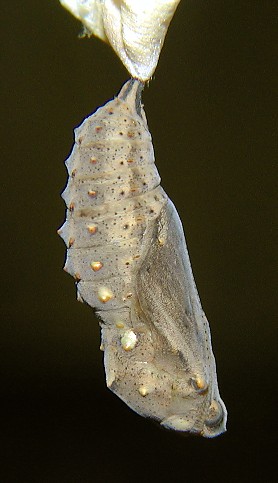For the first half of our lesson the kids were the most excited/rambunctious we have seen them yet; but all in all I would have to say that our lesson went well. We did much better this week with time management and we were able to complete all of the activities that we had intended to without running over into recess or specials. We were also able to incorporate another short video (about the emerging butterfly) into our lesson this week which the children love and constantly ask us to show more of. Unfortunately with the way the class is designed, it is very hard to find a wall to project a video onto; as a result, we have the students sit in a close semi-circle around a laptop. Although the kids aren’t phased by it, their close proximity to each other tends to make them a little more chatty than usual which tends to make it more challenging for us to explain what is going on and to have the students watch for certain things. From our helpful feedback from our lesson, we realize that if we show this video or another like it in the future, it would be helpful to show the movie twice and to pose questions for the students to watch for previous to watching the video.
 We also took a risk this week and asked the students to write about two things they saw in the video. This can be challenging for young students because they have to think back about what they say and then explain this in writing. As a whole, the class is very slow at writing and often needs to be further prompted to complete writing tasks. In past weeks we have written the beginning of sentences (or cloze sentences) on the board for them and had them complete the sentence based on their observations. For example, one week we wrote “I see __________ head capsules” on the board to help prompt students to write about the head capsules which we were learning about. We also wrote something like “My caterpillar looks like it is_____________” . For this lesson however, we left it open to the students to see what they could come up with on their own. We made sure walk around and assist students who appeared to be stuck or struggling with the activity. All in all, however, the students do seem to be doing better with their writing, several of them were able to write complete sentences about what they saw with proper capitalization with very minimal if any assistance.
We also took a risk this week and asked the students to write about two things they saw in the video. This can be challenging for young students because they have to think back about what they say and then explain this in writing. As a whole, the class is very slow at writing and often needs to be further prompted to complete writing tasks. In past weeks we have written the beginning of sentences (or cloze sentences) on the board for them and had them complete the sentence based on their observations. For example, one week we wrote “I see __________ head capsules” on the board to help prompt students to write about the head capsules which we were learning about. We also wrote something like “My caterpillar looks like it is_____________” . For this lesson however, we left it open to the students to see what they could come up with on their own. We made sure walk around and assist students who appeared to be stuck or struggling with the activity. All in all, however, the students do seem to be doing better with their writing, several of them were able to write complete sentences about what they saw with proper capitalization with very minimal if any assistance. Over the weekend, Mia and I created a large 3-D model of a butterfly to help us develop an interactive lesson to teach the students about the different parts of the butterfly. We told the students that the butterfly came in pieces and that we needed their help putting it together by following the clues that were with it. Each group was given 2 pieces (body parts) of the butterfly and had to decide if they thought they had the part that the clue was describing. After we read the clue aloud groups would raise their hands if they believe they had the right piece, if there was more than one group that thought they had the correct piece we would read additional clues to help them decide which piece was correct. After each piece was added we had the students label the body part on their worksheets. The students seemed to really enjoy this part of the lesson and now they have a large 3-D model of a butterfly with labeled body parts hanging in the room to help them remember what they learned this week. We wanted to have the students name the butterfly but we did unfortunately run out of time for that.
Overall, the lesson was a lot of fun and I can’t wait for next week!

